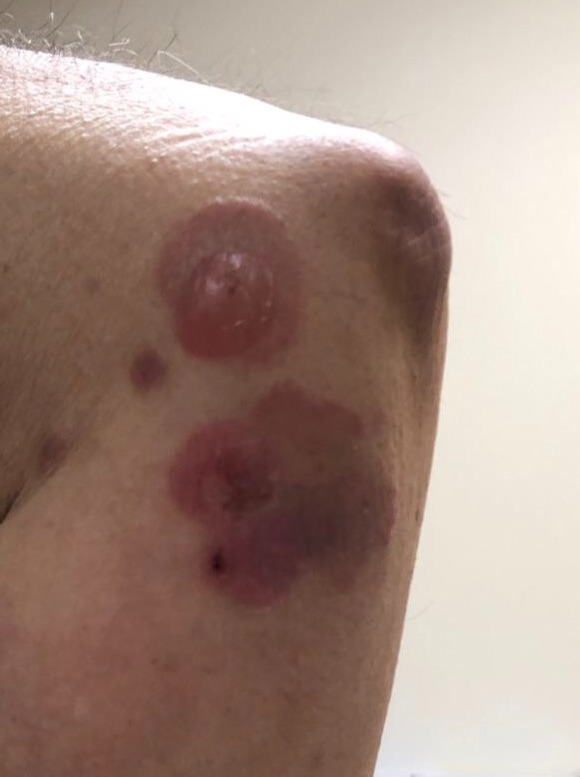Back
Poster Session A - Sunday Afternoon
A0406 - Atypical Cutaneous Eruption to Mesalamine
Sunday, October 23, 2022
5:00 PM – 7:00 PM ET
Location: Crown Ballroom
- MS
Michael Siegel, DO
University of Illinois at Chicago
Chicago, IL
Presenting Author(s)
Michael Siegel, DO1, Elie Ghoulam, MD2, Sandra Naffouj, MD1, Itishree Trivedi, MD3
1University of Illinois at Chicago, Chicago, IL; 2University of Ilinois at Chicago, Chicago, IL; 3University of Illinois Medical Center, Chicago, IL
Introduction: Mesalamine, 5-aminosalicylic acid (5-ASA), is an anti-inflammatory drug that is used in the treatment of ulcerative colitis (UC). Mesalamine use is associated with rare, but well-described hypersensitivity reactions with renal, cardiac, and pulmonary involvement. We present a case of an atypical cutaneous reaction in a patient with UC associated with mesalamine therapy.
Case Description/Methods: An 85 year old male with hypertension, diabetes, and mucinous adenocarcinoma of the lung presented to inflammatory bowel disease (IBD) clinic to establish care. He was diagnosed with UC in the 1970s and had previously been treated with sulfasalazine. For lung cancer, patient was treated with pembrolizumab, which was discontinued 18 months prior.
Upon presentation, he reported 1-2 bowel movements daily with intermittent blood per rectum and right lower quadrant pain. Colonoscopy done 2 years prior to presentation had demonstrated quiescent disease.
The patient was started on mesalamine 4800mg daily. 2 weeks after starting mesalamine, patient endorsed hypopigmented spots on scalp and torso, generalized pruritis, and bilateral foot pain. Mesalamine was stopped. Within 2 weeks, patient developed a new rash (Image 1). He was urgently referred to Dermatology clinic and noted to have tense bullae and pruritic pink plaques on his torso.
Punch biopsy was performed, and labs were sent including pemphigoid Ab panel that confirmed diagnosis of bullous pemphigoid (BP). Patient was started on prednisone 40mg daily for 2 weeks. At return visit in two weeks, skin lesions had resolved, and the patient was weaned from prednisone.
Discussion: We presented a case of drug-associated bullous pemphigoid (DABP) associated with mesalamine therapy. There are multiple reports of mesalamine-induced Steven Johnson Syndrome, but BP has been rarely described. Although our patient was on a PD-1 inhibitor, his discontinuation 18 months prior makes the likelihood of it causing his cutaneous symptoms exceedingly unlikely. Mesalamine-DABP is a cutaneous manifestation of mesalamine hypersensitivity and can be recurrent upon re-introduction of mesalamine. Although a rare complication, mesalamine-DABP is an adverse event that gastroenterology providers should be aware of when starting patients on mesalamine.

Disclosures:
Michael Siegel, DO1, Elie Ghoulam, MD2, Sandra Naffouj, MD1, Itishree Trivedi, MD3. A0406 - Atypical Cutaneous Eruption to Mesalamine, ACG 2022 Annual Scientific Meeting Abstracts. Charlotte, NC: American College of Gastroenterology.
1University of Illinois at Chicago, Chicago, IL; 2University of Ilinois at Chicago, Chicago, IL; 3University of Illinois Medical Center, Chicago, IL
Introduction: Mesalamine, 5-aminosalicylic acid (5-ASA), is an anti-inflammatory drug that is used in the treatment of ulcerative colitis (UC). Mesalamine use is associated with rare, but well-described hypersensitivity reactions with renal, cardiac, and pulmonary involvement. We present a case of an atypical cutaneous reaction in a patient with UC associated with mesalamine therapy.
Case Description/Methods: An 85 year old male with hypertension, diabetes, and mucinous adenocarcinoma of the lung presented to inflammatory bowel disease (IBD) clinic to establish care. He was diagnosed with UC in the 1970s and had previously been treated with sulfasalazine. For lung cancer, patient was treated with pembrolizumab, which was discontinued 18 months prior.
Upon presentation, he reported 1-2 bowel movements daily with intermittent blood per rectum and right lower quadrant pain. Colonoscopy done 2 years prior to presentation had demonstrated quiescent disease.
The patient was started on mesalamine 4800mg daily. 2 weeks after starting mesalamine, patient endorsed hypopigmented spots on scalp and torso, generalized pruritis, and bilateral foot pain. Mesalamine was stopped. Within 2 weeks, patient developed a new rash (Image 1). He was urgently referred to Dermatology clinic and noted to have tense bullae and pruritic pink plaques on his torso.
Punch biopsy was performed, and labs were sent including pemphigoid Ab panel that confirmed diagnosis of bullous pemphigoid (BP). Patient was started on prednisone 40mg daily for 2 weeks. At return visit in two weeks, skin lesions had resolved, and the patient was weaned from prednisone.
Discussion: We presented a case of drug-associated bullous pemphigoid (DABP) associated with mesalamine therapy. There are multiple reports of mesalamine-induced Steven Johnson Syndrome, but BP has been rarely described. Although our patient was on a PD-1 inhibitor, his discontinuation 18 months prior makes the likelihood of it causing his cutaneous symptoms exceedingly unlikely. Mesalamine-DABP is a cutaneous manifestation of mesalamine hypersensitivity and can be recurrent upon re-introduction of mesalamine. Although a rare complication, mesalamine-DABP is an adverse event that gastroenterology providers should be aware of when starting patients on mesalamine.

Figure: Drug-associated bullous pemphigoid after mesalamine treatment
Disclosures:
Michael Siegel indicated no relevant financial relationships.
Elie Ghoulam indicated no relevant financial relationships.
Sandra Naffouj indicated no relevant financial relationships.
Itishree Trivedi indicated no relevant financial relationships.
Michael Siegel, DO1, Elie Ghoulam, MD2, Sandra Naffouj, MD1, Itishree Trivedi, MD3. A0406 - Atypical Cutaneous Eruption to Mesalamine, ACG 2022 Annual Scientific Meeting Abstracts. Charlotte, NC: American College of Gastroenterology.
